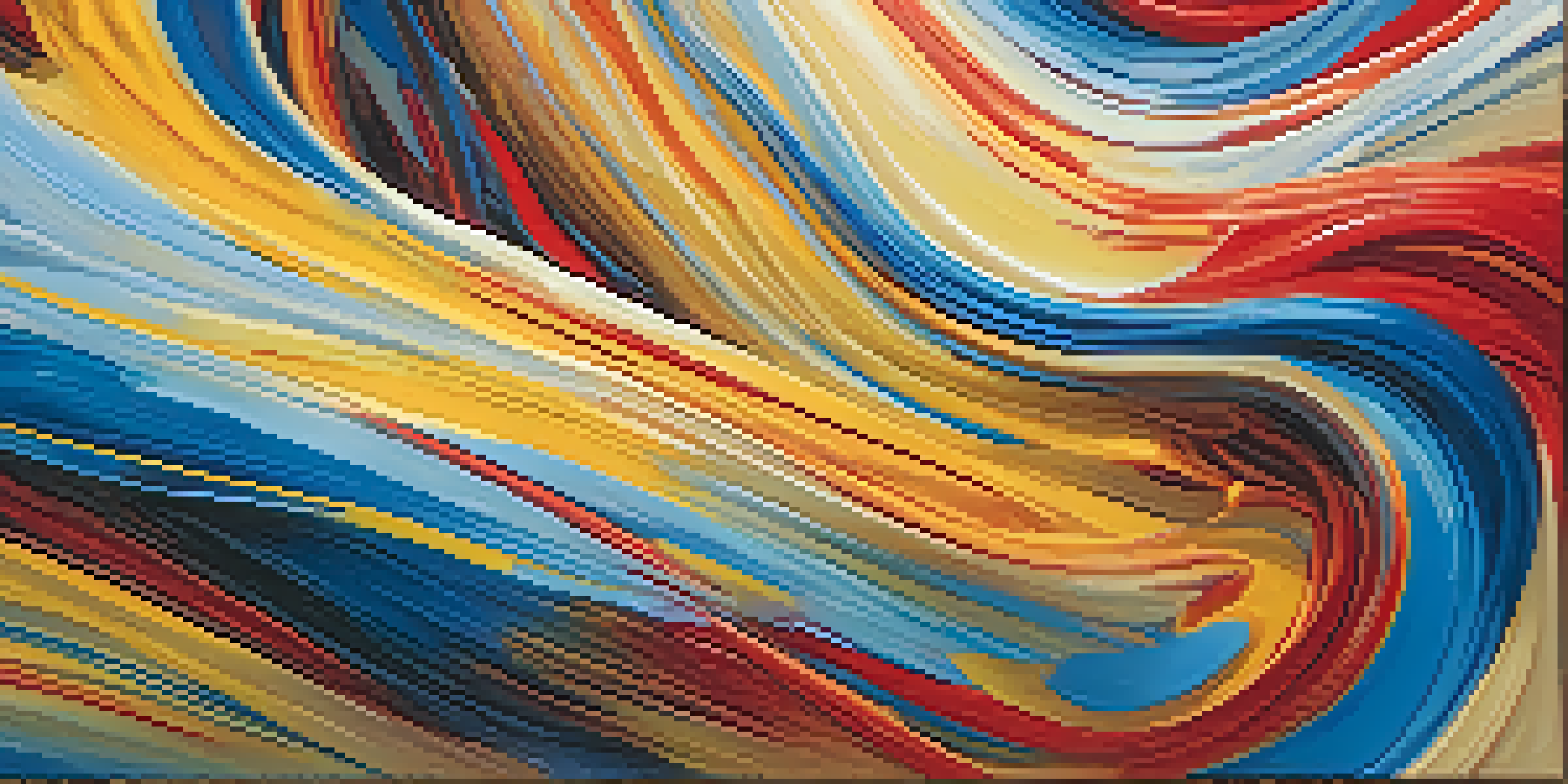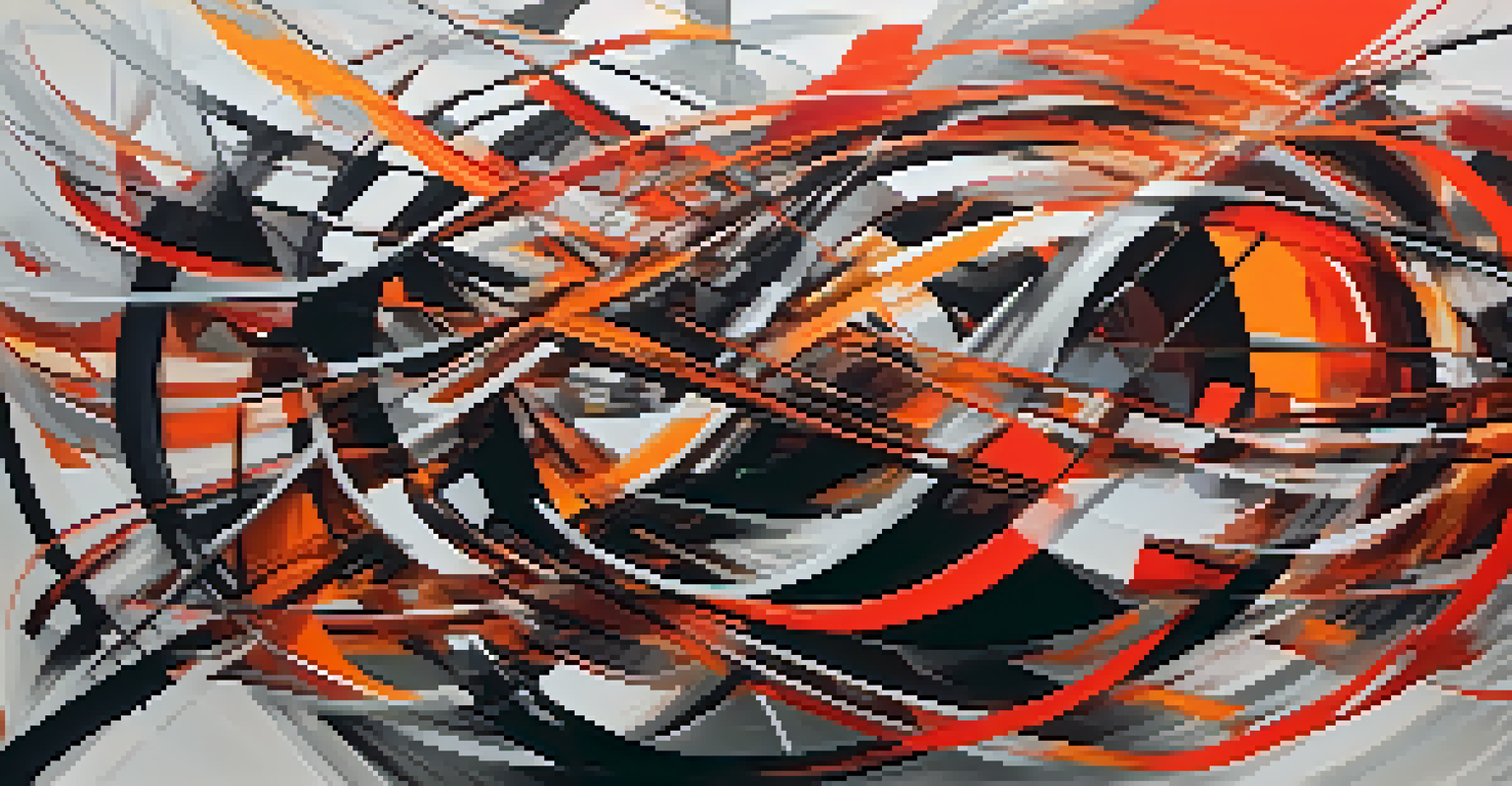Exploring Personal Narratives Through Abstract Painting Styles

Understanding Abstract Painting and Its Appeal
Abstract painting is more than just splashes of color; it's a form of expression that transcends literal representation. It allows artists to convey emotions, thoughts, and personal experiences in a way that traditional art forms might not. By breaking away from the constraints of realism, abstract art invites viewers to interpret the work through their own lens.
Abstract art enables the artist to perceive beyond the tangible, to extract meaning from the chaos of the world.
For many, the appeal of abstract painting lies in its ambiguity. This lack of defined shapes and figures creates a space where personal narratives can thrive. It encourages both the artist and the audience to engage in a dialogue about what the work means to them, making each experience unique and deeply personal.
In this way, abstract painting serves as a visual language, where colors and forms become symbols of individual stories. Just as we all have different life experiences, we also interpret abstract art in diverse ways, making it a powerful medium for personal expression.
The Role of Color in Personal Storytelling
Color plays a vital role in abstract painting, acting as a tool for emotional expression. Each hue can evoke distinct feelings; for example, blues might bring a sense of calm, while reds can ignite passion. Artists often choose colors based on their own experiences, effectively using their canvas as a diary of emotions.

When viewers encounter an abstract piece, their emotional responses to the colors can resonate with their own life stories. This connection highlights how color not only communicates the artist's intent but also invites the audience to reflect on their experiences. The interaction between color and emotion creates a rich tapestry of narratives across the canvas.
Abstract Art as Personal Expression
Abstract painting allows artists to convey their emotions and experiences, inviting viewers to interpret the work through their own perspectives.
This interplay makes abstract painting a unique form of storytelling, where both artist and viewer contribute to the narrative. As different colors trigger various memories and feelings, the artwork becomes a shared space for personal reflection and connection.
Shapes and Forms: A Reflection of Life Experiences
In abstract art, shapes and forms can symbolize various aspects of life, from struggles to triumphs. Jagged lines might represent conflict, while smooth curves can convey serenity. This visual language allows artists to embody their personal journeys in a way that resonates with viewers on a subconscious level.
Color is the keyboard, the eyes are the harmonies, the soul is the piano with many strings.
As we explore these shapes, we can find parallels to our own lives. For instance, a chaotic arrangement of forms might mirror a tumultuous period, while harmonious patterns could reflect a time of peace. This aspect of abstract painting encourages viewers to engage with their own narratives, fostering a deeper understanding of themselves.
Thus, the shapes within an abstract painting become more than mere design elements; they transform into vessels of personal stories. Each artist's unique interpretation of their experiences adds layers of meaning that viewers can unpack, creating an ongoing dialogue between the artwork and its audience.
The Creative Process: Merging Experience and Art
The journey of creating abstract art is often a deeply personal one. Artists frequently draw inspiration from their own life experiences, channeling their emotions and thoughts directly onto the canvas. This process can be both therapeutic and revealing, allowing artists to confront and express their feelings in new ways.
As artists experiment with different styles and techniques, they often find that their work evolves alongside their personal narratives. Each brushstroke can represent a moment in time, a memory, or a feeling that they wish to capture. This organic relationship between the artist and their work adds a layer of authenticity that is palpable to viewers.
Color's Role in Emotional Connection
The use of color in abstract art evokes distinct feelings, creating a dialogue between the artwork and the viewer's personal narratives.
In this way, the creative process not only produces art but also serves as a form of storytelling. By sharing their journey through abstract painting, artists invite others to reflect on their own experiences, creating a shared space for understanding and connection.
The Viewer’s Role in Interpreting Personal Narratives
While abstract paintings are often rooted in the artist's personal experiences, the viewer plays a crucial role in interpreting these narratives. Each person brings their own background, emotions, and memories to the artwork, which can lead to vastly different interpretations. This collaborative aspect of abstract art makes it an engaging experience for everyone involved.
As viewers stand before a piece, they might find themselves reflecting on their own life stories, discovering connections between the artwork and their experiences. This process of interpretation can be enlightening, prompting personal insights and emotional revelations. The abstract painting becomes a mirror of sorts, reflecting the viewer's own narrative back to them.
Ultimately, this interaction enriches the experience of abstract art, transforming it into a dynamic conversation. The viewer's perspective not only enhances their appreciation of the work but also deepens their understanding of their own personal journey.
Cultural Influences: Shaping Personal Narratives
Cultural background plays a significant role in shaping both the artist's and viewer's narratives within abstract painting. Different cultures often have unique color associations, symbolism, and artistic traditions that influence how art is created and interpreted. This diversity adds layers of meaning to abstract works, enriching the storytelling aspect.
For instance, an artist from a vibrant culture might use bold colors and dynamic forms to express their life experiences, while someone from a more subdued background may favor muted tones and simpler shapes. These cultural influences can lead to varied interpretations among viewers, as one's cultural lens deeply colors their understanding of the artwork.
Cultural Influences on Interpretation
Cultural backgrounds shape how both artists and viewers interpret abstract paintings, enriching the storytelling and connection within the art.
By exploring these cultural dimensions, abstract painting becomes not just a personal narrative but a shared one that bridges differences. It invites a global conversation about identity, experience, and expression, showcasing the myriad ways we can connect through art.
Finding Your Own Voice Through Abstract Art
For those looking to explore their personal narratives, abstract painting can be a liberating medium. It encourages individuals to tap into their emotions and experiences without the constraints of realism. This freedom allows for self-discovery and creative expression, making it an ideal starting point for anyone interested in art.
As you begin to experiment with colors, shapes, and techniques, you may find that your own story unfolds on the canvas. This process can be profoundly cathartic, offering a chance to reflect on your experiences and emotions. Each piece you create becomes a chapter in your narrative, showcasing your unique voice and perspective.

Ultimately, engaging with abstract painting is about embracing your individuality and allowing your story to emerge. Whether you're a seasoned artist or a curious beginner, the canvas invites you to explore and express the complexities of your personal journey.